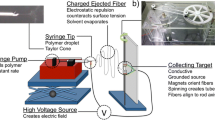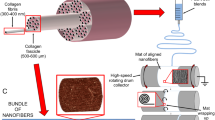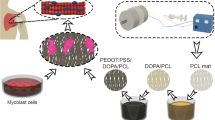Abstract
Scaffolds functionalized with graded changes in both fiber alignment and mineral content are more appealing for tendon-bone healing. This study reports the healing of rotator cuff injury using a heterogeneous nanofiber scaffold, which is associated with a structural gradating from aligned to random and an increasing gradient of mineral content in the same orientation. The photothermal-triggered structural change of a nanofiber scaffold followed by graded mineralization is key to constructing such scaffolds. This type of scaffold was found to be biocompatible and provide beneficial contact guidance in the manipulation of tendon-derived stem cell morphologies in vitro. Specifically, tenogenic and osteogenic differentiation of tendon-derived stem cells were simultaneously achieved using the fabricated scaffold. In vivo investigation also showed the improved healing of rabbit rotator cuff injuries based on immunohistochemical analysis and biomechanical investigation that indicates the promising potential of a dual-gradient nanofiber scaffold in clinical tendon-bone healing.
Graphical abstract
Dual-gradient nanofiber scaffold with transitions in both surface structure and mineral content was designed and manufactured to replicate the native interface between tendon and bone to facilitate the tendon-bone healing in a rabbit rotator cuff injury model.









Similar content being viewed by others
References
Tashjian RZ. Epidemiology, natural history, and indications for treatment of rotator cuff tears. Clin Sports Med 2012;31:589–604.
Iannotti JP, Deutsch A, Green A, Rudicel S, Christensen J, Marraffino S, Rodeo S. Time to failure after rotator cuff repair: a prospective imaging study. J Bone Joint Surg Am 2013;95:965–71.
Neri BR, Chan KW, Kwon YW. Management of massive and irreparable rotator cuff tears. J Shoulder Elbow Surg 2009;18:808–18.
Pennisi E. Tending tender tendons. Science 2002;295:1011.
Butler DL, Juncosa N, Dressler MR. Functional efficacy of tendon repair processes. Annu Rev Biomed Eng 2004;6:303–29.
Lin Y, Zhang L, Liu NQ, Yao Q, Van Handel B, Xu Y, Wang C, Evseenko D, Wang L. In vitro behavior of tendon stem/progenitor cells on bioactive electrospun nanofiber membranes for tendon-bone tissue engineering applications. Int J Nanomed 2019;14:5831–48.
Tang Y, Chen C, Liu F, Xie S, Qu J, Li M, Li Z, Li X, Shi Q, Li S, Li X, Hu J, Lu H. Structure and ingredient-based biomimetic scaffolds combining with autologous bone marrow-derived mesenchymal stem cell sheets for bone-tendon healing. Biomaterials 2020;241:119837.
Chae S, Sun Y, Choi YJ, Ha DH, Jeon IH, Cho DW. 3D cell-printing of tendon-bone interface using tissue-derived extracellular matrix bioinks for chronic rotator cuff repair. Biofabrication 2021;13:035005.
Rothrauff BB, Yang G, Tuan RS. Tissue-specific bioactivity of soluble tendon-derived and cartilage-derived extracellular matrices on adult mesenchymal stem cells. Stem Cell Res Ther 2017;8:133.
Xie J, Li X, Lipner J, Manning CN, Schwartz AG, Thomopoulos S, Xia Y. “Aligned-to-random” nanofiber scaffolds for mimicking the structure of the tendon-to-bone insertion site. Nanoscale 2010;2:923–6.
Kishan AP, Robbins AB, Mohiuddin SF, Jiang M, Moreno MR, Cosgriff-Hernandez EM. Fabrication of macromolecular gradients in aligned fiber scaffolds using a combination of in-line blending and air-gap electrospinning. Acta Biomater 2017;56:118–28.
Li H, Wu T, Xue J, Ke Q, Xia Y. Transforming nanofiber mats into hierarchical scaffolds with graded changes in porosity and/or nanofiber alignment. Macromol Rapid Commun 2020;41:e1900579.
Li X, Cheng R, Sun Z, Su W, Pan G, Zhao S, Zhao J, Cui W. Flexible bipolar nanofibrous membranes for improving gradient microstructure in tendon-to-bone healing. Acta Biomater 2017;61:204–16.
Chen W, Sun Y, Gu X, Cai J, Liu X, Zhang X, Chen J, Hao Y, Chen S. Conditioned medium of human bone marrow-derived stem cells promotes tendon-bone healing of the rotator cuff in a rat model. Biomaterials 2021;271:120714.
Laranjeira M, Domingues RMA, Costa-Almeida R, Reis RL, Gomes ME. 3D mimicry of native-tissue-fiber architecture guides tendon-derived cells and adipose stem cells into artificial tendon constructs. Small 2017;13:1700689.
Lui PP, Chan KM. Tendon-derived stem cells (TDSCs): from basic science to potential roles in tendon pathology and tissue engineering applications. Stem Cell Rev Rep 2011;7:883–97.
Wu T, Li H, Xue J, Mo X, Xia Y. Photothermal welding, melting, and patterned expansion of nonwoven mats of polymer nanofibers for biomedical and printing applications. Angew Chem Int Ed Engl 2019;58:16416–21.
Li X, Xie J, Lipner J, Yuan X, Thomopoulos S, Xia Y. Nanofiber scaffolds with gradations in mineral content for mimicking the tendon-to-bone insertion site. Nano Lett 2009;9:2763–8.
Tas AC, Bhaduri SB. Rapid coating of Ti6Al4V at room temperature with a calcium phosphate solution similar to 10× simulated body fluid. J Mater Res 2004;19:2742–9.
Yamaguchi K, Ditsios K, Middleton WD, Hildebolt CF, Galatz LM, Teefey SA. The demographic and morphological features of rotator cuff disease. A comparison of asymptomatic and symptomatic shoulders. J Bone Joint Surg Am 2006;88:1699–704.
Isaksson H, Harjula T, Koistinen A, Iivarinen J, Seppänen K, Arokoski JP, Brama PA, Jurvelin JS, Helminen HJ. Collagen and mineral deposition in rabbit cortical bone during maturation and growth: effects on tissue properties. J Orthop Res 2010;28:1626–33.
Otarodifard K, Wong J, Preston CF, Tibone JE, Lee TQ. Relative fixation strength of rabbit subscapularis repair is comparable to human supraspinatus repair at time. Clin Orthop Relat Res 2014;472:2440–7.
Grumet RC, Hadley S, Diltz MV, Lee TQ, Gupta R. Development of a new model for rotator cuff pathology: the rabbit subscapularis muscle. Acta Orthop 2009;80:97–103.
Jing Z, Dexin T, Zihan L, et al. Ultrafast bone-like apatite formation on highly porous poly(l-lactic acid)-hydroxyapatite fibres. Mater Sci Eng C Mater Biol Appl 2020;116:111168.
Liu W, Lipner J, Xie J, Manning CN, Thomopoulos S, Xia Y. Nanofiber scaffolds with gradients in mineral content for spatial control of osteogenesis. ACS Appl Mater Interfaces 2014;6:2842–9.
Yang G, Yao Y, Wang X. Comparative study of kerateine and keratose based composite nanofibers for biomedical applications. Mater Sci Eng C Mater Biol Appl 2018;83:1–8.
Dong Y, Zheng Y, Zhang K, Yao Y, Wang L, Li X, Yu J, Ding B. Electrospun nanofibrous materials for wound healing. Adv Fiber Mater 2020;2:212–27.
Li Y, Shen Q, Shen J, Ding X, Liu T, He J, Zhu CY, Zhao D, Zhu JD. Multifunctional fibroblasts enhanced via thermal and freeze-drying post-treatments of aligned electrospun nanofiber membranes. Adv Fiber Mater 2021;3:1–16.
Biehl JK, Yamanaka S, Desai TA, Boheler KR, Russell B. Proliferation of mouse embryonic stem cell progeny and the spontaneous contractile activity of cardiomyocytes are affected by microtopography. Dev Dyn 2009;238:1964–73.
Brassard JA, Lutolf MP. Engineering stem cell self-organization to build better organoids. Cell Stem Cell 2019;24:860–76.
Huang AH, Lu HH, Schweitzer R. Molecular regulation of tendon cell fate during development. J Orthop Res 2015;33:800–12.
Järvinen TA, Kannus P, Järvinen TL, Jozsa L, Kalimo H, Järvinen M. Tenascin-C in the pathobiology and healing process of musculoskeletal tissue injury. Scand J Med Sci Sports 2000;10:376–82.
Lin B, Srikanth P, Castle AC, Nigwekar S, Malhotra R, Galloway JL, Sykes DB, Rajagopal J. Modulating cell fate as a therapeutic strategy. Cell Stem Cell 2018;23:329–41.
Yin Z, Chen X, Chen JL, Shen WL, Hieu Nguyen TM, Gao L, Ouyang HW. The regulation of tendon stem cell differentiation by the alignment of nanofibers. Biomaterials 2010;31:2163–75.
Nourissat G, Berenbaum F, Duprez D. Tendon injury: from biology to tendon repair. Nat Rev Rheumatol 2015;11:223–33.
He SK, Ning LJ, Yao X, Hu RN, Cui J, Zhang Y, Ding W, Luo JC, Qin TW. Hierarchically demineralized cortical bone combined with stem cell-derived extracellular matrix for regeneration of the tendon-bone interface. Am J Sports Med 2021;49:1323–32.
Massaro MS, Pálek R, Rosendorf J, Červenková L, Liška V, Moulisová V. Decellularized xenogeneic scaffolds in transplantation and tissue engineering: immunogenicity versus positive cell stimulation. Mater Sci Eng C Mater Biol Appl 2021;127:112203.
Qu D, Mosher CZ, Boushell MK, Lu HH. Engineering complex orthopaedic tissues via strategic biomimicry. Ann Biomed Eng 2015;43:697–717.
Hirose K, Kondo S, Choi HR, Mishima S, Iwata H, Ishiguro N. Spontaneous healing process of a supraspinatus tendon tear in rabbits. Arch Orthop Trauma Surg 2004;124:374–7.
Shi D, Shen J, Zhang Z, Shi C, Chen M, Gu Y, Liu Y. Preparation and properties of dopamine-modified alginate/chitosan-hydroxyapatite scaffolds with gradient structure for bone tissue engineering. J Biomed Mater Res A 2019;107:1615–27.
Kim BJ, Cho YW, Jo CH. Regeneration of the rotator cuff tendon-to-bone interface using umbilical cord-derived mesenchymal stem cells and gradient extracellular matrix scaffolds from adipose tissue in a rat model. Acta Biomater 2020;114:104–16.
Baldino L, Cardea S, Maffulli N, Reverchon E. Regeneration techniques for bone-to-tendon and muscle-to-tendon interfaces reconstruction. Br Med Bull 2016;117:25–37.
Nowlin J, Bismi MA, Delpech B, Dumas P, Zhou Y, Tan GZ. Engineering the hard-soft tissue interface with random-to-aligned nanofiber scaffolds. Nanobiomedicine 2018;5:1849543518803538.
Xie J, Ma B, Michael PL, Shuler FD. Fabrication of nanofiber scaffolds with gradations in fiber organization and their potential applications. Macromol Biosci 2012;12:1336–41.
Samavedi S, Vaidya P, Gaddam P, Whittington AR, Goldstein AS. Electrospun meshes possessing region-wise differences in fiber orientation, diameter, chemistry and mechanical properties for engineering bone-ligament-bone tissues. Biotechnol Bioeng 2014;111:2549–59.
Yang R, Li G, Zhuang C, Yu P, Ye T, Zhang Y, Shang P, Huang J, Cai M, Wang L, Cui W, Deng L. Gradient bimetallic ion-based hydrogels for tissue microstructure reconstruction of tendon-to-bone insertion. Sci Adv 2021;7:3816.
Wu T, Xue J, Li H, Zhu C, Mo X, Xia Y. General method for generating circular gradients of active proteins on nanofiber scaffolds sought for wound closure and related applications. ACS Appl Mater Interfaces 2018;10:8536–45.
Xue J, Wu T, Qiu J, Rutledge S, Tanes ML, Xia Y. promoting cell migration and neurite extension along uniaxially aligned nanofibers with biomacromolecular particles in a density gradient. Adv Funct Mater 2020;30:2002031.
Ma J, Smietana MJ, Kostrominova TY, Wojtys EM, Larkin LM, Arruda EM. Three-dimensional engineered bone-ligament-bone constructs for anterior cruciate ligament replacement. Tissue Eng Part A 2012;18:103–16.
Elst L, Lima C, Kurtoglu MG, Koraganji VN, Zheng MG, Gumennik A. 3D printing in fiber-device technology. Adv Fiber Mater 2021;3:59–75.
Acknowledgements
This research was supported by National Natural Science Foundation of China (31872310, 82001970), Natural Science Foundation of Shandong Province (ZR2019MH097, ZR2021YQ17), Young Elite Scientists Sponsorship Program by CAST (No. YESS20200097), and startup funds from Qingdao University (T.W.).
Author information
Authors and Affiliations
Contributions
CY: methodology, formal analysis, data curation, software, writing-original draft. TW: methodology. HD: formal analysis, writing-original draft. NL: methodology, writing-review & editing. YZ: formal analysis. HJ: methodology, writing-original draft. PZ: methodology. ZS: methodology. ZS: methodology. TW: conceptualization, methodology, resources, supervision, funding acquisition, writing-review & editing. XM: conceptualization, resources. TY: project administration, resources, supervision, funding acquisition.
Corresponding authors
Ethics declarations
Conflict of interest
On behalf of all authors, the corresponding author states that there is no conflict of interest.
Additional information
Publisher's Note
Springer Nature remains neutral with regard to jurisdictional claims in published maps and institutional affiliations.
Electronic Supplementary Material
Below is the link to the electronic supplementary material.
Rights and permissions
About this article
Cite this article
Yu, C., Wang, T., Diao, H. et al. Photothermal-Triggered Structural Change of Nanofiber Scaffold Integrating with Graded Mineralization to Promote Tendon–Bone Healing. Adv. Fiber Mater. 4, 908–922 (2022). https://doi.org/10.1007/s42765-022-00154-7
Received:
Accepted:
Published:
Issue Date:
DOI: https://doi.org/10.1007/s42765-022-00154-7




